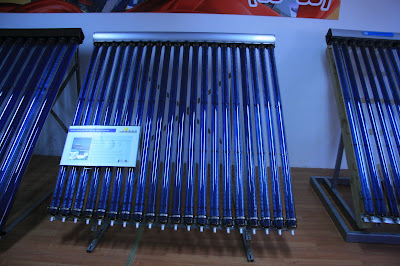Here at International Renewable Energy and BestSolarBuy.com, we are commonly asked what the differences are between solar PV
(photovoltaics) and solar-thermal energy (STE).
Around the world, the one system that is most commonly used is solar-thermal for heating water. It requires no electricity and is used primarily in developing nations and China. Due to government incentives and initiatives to save energy throughout the country, solar-thermal systems cover an estimated 80% of homes and commercial buildings in China making it by far the most widely used system globally. Due to the lack of moving parts and need for no electricity solar thermal is the clear solution to water heating requirements around the globe. Solar-thermal systems can save an estimated 30% of the overall electrical requirements of a home and up to 50% in a business which requires heavy usage of heated water.
 |
| Sunda Solar-thermal Energy Panels that are common in Asia and in Europe (photo taken by Robb Childs). |
Solar photovoltaic systems are more common in America than solar-thermal systems. However, both systems work in coordination in Europe and are part of the reason solar initiatives are working so well in places like Spain and Germany. Photovoltaic systems use the sun’s rays to create energy at the atomic level using a process first discovered by Dr. Albert Einstein. Dr. Einstein referred to this phenomenon as the "photoelectric effect". Today it is more commonly referred to as photovoltaics, or PV for short and is the cornerstone of electrical power generation on satellites in orbit or even on the International Space Station. These panels line the roof tops and fields across America.
 |
| Solar photovoltaic panels (Solar PV) panels installed on a rooftop (photo taken by Robb Childs) |
In short:
Photovoltaics (PV): transform free energy from the sun into electricity
Solar-thermal systems (STE): transform free energy from the sun into efficient heat.
Together they are just a small part of the overall solution of energy independence and affordable solutions that will become the future of the common American lifestyle.
Written by Robb Childs and Eric Layton


No comments:
Post a Comment